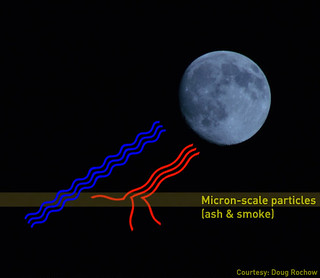Get ready: 'Once in a Blue Moon' opportunity on Friday
Meteorologist/Science Writer
Tuesday, July 28, 2015, 4:21 PM - Friday, July 31 will see a rarity in our night skies - the first "blue moon" since 2012, and the last one until 2018. But what is a blue moon and why are they so rare?
Look up on Friday night and, provided that you have reasonably clear skies, you'll see a fairly average full moon crossing the sky. It might look a little bit bigger than normal for anyone who happens to be keeping close track, but it won't be at closest approach (perigee) or farthest approach (apogee). It won't even be blue (at least not any more blue than it normally looks). However, it will still be a rare occurrence - enough to invoke the phrase "once in a blue moon."
What is a "Blue Moon"?
The origin of the term "blue moon" is something of a mystery in of itself. It apparently has no relation to anything astronomical, but was simply a way of expressing the absurdity of a statement - "what you said is just like saying that the moon is blue."
As for the modern meaning of "blue moon," there are actually three definitions:
-
According to the Maine Farmer's Almanac a "blue moon" is the third full moon that occurs during an astronomical season with four full moons (normally there are three full moons during a season). There are three full moons during Summer 2015 - July 2, July 31 and August 28 - so this full moon doesn't satisfy that condition.
-
According to Pagan beliefs, the "blue moon" is the second full moon that occurs during an astrological month - the period when the Sun is passing through a particular sign of the zodiac. As the July 2 and July 31 full moons occur when the Sun is in different signs (Cancer and Leo), it also doesn't qualify for this type of "blue moon."
-
The most common modern definition is what we're seeing on Friday - the second of two full moons that occur within the same calendar month. This is based on a misinterpretation of the Farmer's Almanac definition, and was printed in the March 1946 issue of Sky & Telescope. Regardless of being wrong, it has still become the most popular definition.
How rare is "rare"?
The phrase "once in a blue moon" is closely linked with rare and special events. How rare is a blue moon, though?
All three types of blue moons happen just about once every three years.
For seasonal blue moons, the last one was on August 20, 2013, and the next will fall on May 26, 2016.
By the Pagan definition, using the tropical zodiac, the last "blue moon" occurred on July 22, 2013, and the next will occur on May 21, 2016. By the sidereal zodiac, the last was on May 14, 2014, and the next will be on November 14, 2016 (only 2.5 years apart).
The last calendar blue moon was on August 31, 2012. This next full moon, coming on July 31, will be the 36th full moon since then, and after this there are 30 full moons until the next one, on January 31, 2018.
That's not exceedingly rare, by any of the definitions, but waiting nearly 3 years for something can certainly make it seem so.
The reason for the rarity is due to the difference between our calendar months and a lunar month.
|
|
While our months - calendar or astrological - differ in length depending on the month and the year, a lunar month - the time between reaching the same phase, Full to Full, New to New, etc - is always 29.53 days.
The difference not only throws off when different lunar phases happen from month to month, but the timing of full moons and even how many full moons during a year changes over time. It's not often when that 29.53 day lunar month happens to squeeze into one of our calendar months or an astrological month, or when four of them fit into an astronomical season.
It takes awhile for everything to line up properly.
A truly blue moon?
As for the full moon actually looking blue, as the Science@NASA video above details, that is exceptionally rare.
This only happens when tiny particles - volcanic ash particles or smoke particles from forest fires - measuring around a millionth of a metre (a micron) across get lofted up into the sky. Particles of this size scatter red light stronger than other wavelengths, while allowing blue to pass through. So, when moonlight shines through a layer of these particles, it can make the Moon look blue.
Sources: Science@NASA | NASA's Scientific Visualization Studio | Wikipedia




